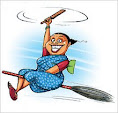 Drs. Indra,Patil,Joshi,Pai & Kalantri have published the results of a cross sectional, doubleblind study conducted by them at Wardha, India.
Drs. Indra,Patil,Joshi,Pai & Kalantri have published the results of a cross sectional, doubleblind study conducted by them at Wardha, India.
What makes this study more exciting is that it was done in India, in a rural environment, and so is very relevant to the Indian Woman ( almost 5/6ths of the patients were women.)
A article in the Journal of Postgraduate Medicine, (March 2004) has something interesting to say.
Doctors at the Department of Medicine, Mahatma Gandhi Institute of Medical Sciences , Sevagram, Wardha (India), along with the School of public Health , University of California (Berkeley), recently carried out experiment and studies to investigate correlations between physical symptoms of hypothyroidism, and actual detected hypothyroidism (thru assays and tests.)
What was interesting was that they found that you could attribute more weightage to certain observed symptoms than others.
The complete text of the paper may be viewed at :
https://tspace.library.utoronto.ca/retrieve/3328/jp04003.pdf
The physical signs studied and enumerated were :

- Coarse skin (hands, forearms, elbows)
- Sluggish movements (time required to perform a specific simple action was measured)

- Pulse rate (less than 60/per min was declared bradycardia)
- swelling on the shin (the shin was pressed for 30 seconds to see if a depression remained)
- puffines of face (boggy eyelids, certain bony structures obscured due to puffiness)
- ankle reflex (study of contraction/relaxation of calf muscle
Of course, these observations need to be supplemented by thyroid tests (TSH et al) to make a defintive diagnoses.
For statistical findings of the study, please refer to the link above.

